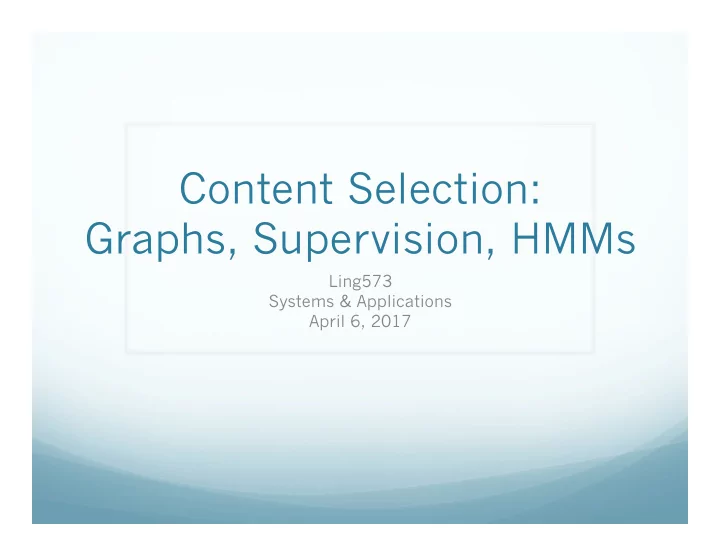

Content Selection: Graphs, Supervision, HMMs Ling573 Systems & Applications April 6, 2017
Roadmap MEAD: classic end-to-end system Cues to content extraction Bayesian topic models Graph-based approaches Random walks Supervised selection Term ranking with rich features
MEAD Radev et al, 2000, 2001, 2004 Exemplar centroid-based summarization system Tf-idf similarity measures Multi-document summarizer Publically available summarization implementation (No warranty) Solid performance in DUC evaluations Standard non-trivial evaluation baseline
Main Ideas Select sentences central to cluster: Cluster-based relative utility Measure of sentence relevance to cluster Select distinct representative from equivalence classes Cross-sentence information subsumption Sentences including same info content said to subsume A) John fed Spot; B) John gave food to Spot and water to the plants. I(B) subsumes I(A) If mutually subsume, form equivalence class
Centroid-based Models Assume clusters of topically related documents Provided by automatic or manual clustering Centroid: “pseudo-document of terms with Count * IDF above some threshold” Intuition: centroid terms indicative of topic Count: average # of term occurrences in cluster IDF computed over larger side corpus (e.g. full AQUAINT)
MEAD Content Selection Input: Sentence segmented, cluster documents (n sents) Compression rate: e.g. 20% Output: n * r sentence summary Select highest scoring sentences based on: Centroid score Position score First-sentence overlap (Redundancy)
Score Computation Score(s i ) = w c C i +w p P i +w f F i C i = Σ i C w,I Sum over centroid values of words in sentence P i =((n-i+1)/n)*C max Positional score: C max :score of highest sent in doc Scaled by distance from beginning of doc F i = S 1 *S i Overlap with first sentence TF-based inner product of sentence with first in doc Alternate weighting schemes assessed Diff’t optima in different papers
Managing Redundancy Alternative redundancy approaches: Redundancymax: Excludes sentences with cosine overlap > threshold Redundancy penalty: Subtracts penalty from computed score R s = 2 * # overlapping wds/(# wds in sentence pair) Weighted by highest scoring sentence in set
System and Evaluation Information ordering: Chronological by document date Information realization: Pure extraction, no sentence revision Participated in DUC 2001, 2003 Among top-5 scoring systems Varies depending on task, evaluation measure Solid straightforward system Publicly available; will compute/output weights
Bayesian Topic Models Perspective: Generative story for document topics Multiple models of word probability, topics General English Input Document Set Individual documents Select summary which minimizes KL divergence Between document set and summary: KL(P D ||P S ) Often by greedily selecting sentences Also global models
Graph-Based Models LexRank (Erkan & Radev, 2004) Key ideas: Graph-based model of sentence saliency Draws ideas from PageRank, HITS, Hubs & Authorities Contrasts with straight term-weighting models Good performance: beats tf*idf centroid
Graph View Centroid approach: Central pseudo-document of key words in cluster Graph-based approach: Sentences (or other units) in cluster link to each other Salient if similar to many others More central or relevant to the cluster Low similarity with most others, not central
Constructing a Graph Graph: Nodes: sentences Edges: measure of similarity between sentences How do we compute similarity b/t nodes? Here: tf*idf (could use other schemes) How do we compute overall sentence saliency? Degree centrality LexRank
Example Graph
Degree Centrality Centrality: # of neighbors in graph Edge(a,b) if cosine_sim(a,b) >= threshold Threshold = 0: Fully connected à uninformative Threshold = 0.1, 0.2: Some filtering, can be useful Threshold >= 0.3: Only two connected pairs in example Also uninformative
LexRank Degree centrality: 1 edge, 1 vote Possibly problematic: E.g. erroneous doc in cluster, some sent. may score high LexRank idea: Node can have high(er) score via high scoring neighbors Same idea as PageRank, Hubs & Authorities Page ranked high b/c pointed to by high ranking pages p ( v ) ∑ p ( u ) = deg( v ) v ∈ adj ( u )
Power Method Input: Adjacency matrix M Initialize p 0 (uniform) t=0 repeat t= t+1 p t =M T p t-1 Until convergence Return p t
LexRank Can think of matrix X as transition matrix of Markov chain i.e. X(i,j) is probability of transition from state i to j Will converge to a stationary distribution (r) Given certain properties (aperiodic, irreducible) Probability of ending up in each state via random walk Can compute iteratively to convergence via: p ( u ) = d p ( v ) ∑ N + (1 − d ) deg( v ) v ∈ adj ( u ) “Lexical PageRank” è “LexRank (power method computes eigenvector )
LexRank Score Example For earlier graph:
Continuous LexRank Basic LexRank ignores similarity scores Except for initial thresholding of adjacency Could just use weights directly (rather than degree) p ( u ) = d cos sim ( u , v ) ∑ N + (1 − d ) p ( v ) ∑ cos sim ( z , v ) v ∈ adj ( u ) z ∈ adj ( v )
Advantages vs Centroid Captures information subsumption Highly ranked sentences have greatest overlap w/adj Will promote those sentences Reduces impact of spurious high-IDF terms Rare terms get very high weight (reduce TF) Lead to selection of sentences w/high IDF terms Effect minimized in LexRank
Example Results Beat official DUC 2004 entrants: All versions beat baselines and centroid
Example Results Beat official DUC 2004 entrants: All versions beat baselines and centroid Continuous LR > LR > degree Variability across systems/tasks
Example Results Beat official DUC 2004 entrants: All versions beat baselines and centroid Continuous LR > LR > degree Variability across systems/tasks Common baseline and component
Recommend
More recommend